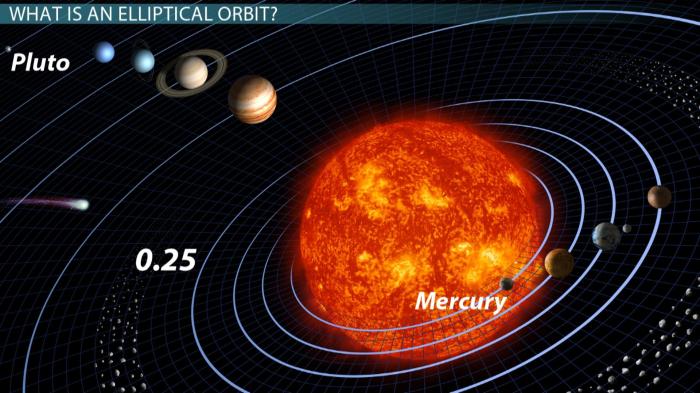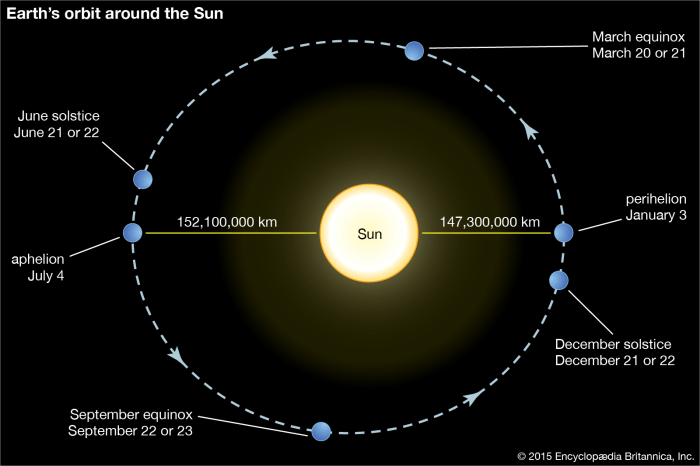A planet orbits a star in an elliptical orbit, a captivating celestial dance that shapes planetary motion and influences the very fabric of life. This journey through orbital mechanics unravels the intricate laws governing planetary trajectories, exploring the forces that shape their paths and the implications for habitability and exoplanet discovery.
From Kepler’s laws to orbital dynamics and tidal effects, we delve into the fascinating world of elliptical orbits, shedding light on the celestial symphony that orchestrates the cosmos.
Orbital Mechanics
Orbital mechanics describes the motion of celestial bodies under the influence of gravity. Elliptical orbits are a fundamental aspect of orbital mechanics, and Kepler’s Laws of Planetary Motion provide a framework for understanding their behavior.
Kepler’s Laws of Planetary Motion
- First Law (Law of Orbits):All planets move in elliptical orbits with the Sun at one focus.
- Second Law (Law of Areas):A line connecting a planet to the Sun sweeps out equal areas in equal time intervals.
- Third Law (Law of Periods):The square of a planet’s orbital period is proportional to the cube of its semi-major axis.
These laws govern the shape, speed, and timing of elliptical orbits.
Equation of an Ellipse
The equation of an ellipse is given by:
(x^2 / a^2) + (y^2 / b^2) = 1
where:
- a is the semi-major axis (half the major axis)
- b is the semi-minor axis (half the minor axis)
This equation describes the shape of an elliptical orbit, with the Sun located at one focus.
Eccentricity
Eccentricity (e) is a measure of the elongation of an elliptical orbit. It is defined as:
e = √(1
(b^2 / a^2))
Eccentricity ranges from 0 to 1, where:
- e = 0: Circular orbit
- 0< e < 1: Elliptical orbit
- e = 1: Parabolic orbit
Eccentricity determines the shape of the orbit, with higher eccentricity resulting in more elongated orbits.
Orbital Parameters
Elliptical orbits are characterized by a set of parameters that describe their size, shape, and orientation.
Semi-Major Axis
The semi-major axis (a) is the average distance between a planet and the Sun. It is half the length of the major axis of the ellipse.
Eccentricity
Eccentricity (e) is as discussed in the previous section.
Orbital Period
The orbital period (T) is the time it takes for a planet to complete one full orbit around the Sun. Kepler’s Third Law relates the orbital period to the semi-major axis:
T^2 = k
a^3
where k is a constant.
Examples, A planet orbits a star in an elliptical orbit
Examples of planets with elliptical orbits include:
- Mercury:e = 0.2056
- Mars:e = 0.0934
- Pluto:e = 0.2488
These planets exhibit varying degrees of eccentricity, resulting in different orbital shapes.
Orbital Dynamics

The motion of a planet in an elliptical orbit is governed by the forces acting on it.
Gravity
Gravity is the primary force that keeps a planet in orbit around the Sun. It is an attractive force that acts between any two objects with mass.
Centripetal Force
Centripetal force is the inward force that keeps a planet moving in a curved path. In an elliptical orbit, the centripetal force is provided by gravity.
Relationship between Velocity and Position
The velocity of a planet in an elliptical orbit varies throughout its orbit. It is highest when the planet is closest to the Sun (perihelion) and lowest when it is farthest from the Sun (aphelion).
Perturbations
Perturbations are external forces that can affect the motion of a planet in an elliptical orbit. These forces can include gravitational interactions with other planets or moons.
Tidal Effects: A Planet Orbits A Star In An Elliptical Orbit

Tidal forces are gravitational forces that result from the difference in gravitational pull between different parts of an object. In the case of an elliptical orbit, tidal forces can cause significant effects.
Tidal Deformations
Tidal forces can deform a planet or moon, causing it to bulge out on the side facing the Sun and on the opposite side.
Tidal Heating
Tidal forces can generate heat within a planet or moon as it deforms. This heat can have significant geological effects.
Examples, A planet orbits a star in an elliptical orbit
Examples of planets or moons where tidal effects are particularly significant include:
- Earth:Tidal forces from the Moon cause ocean tides and affect the Earth’s rotation.
- Jupiter’s moons:Tidal forces from Jupiter cause significant volcanic activity on moons like Io.
Habitability and Exoplanets

Elliptical orbits can have implications for the habitability of planets.
Temperature Variations
Planets in elliptical orbits experience larger temperature variations than planets in circular orbits. This is because they are closer to the Sun at perihelion and farther from the Sun at aphelion.
Atmospheric Conditions
Elliptical orbits can affect the atmospheric conditions of a planet. The varying distance from the Sun can lead to changes in atmospheric pressure and composition.
Recent Discoveries
Recent discoveries of exoplanets with elliptical orbits have raised questions about the potential for life on these planets. Scientists are studying the effects of elliptical orbits on the habitability of these exoplanets.
Frequently Asked Questions
What is an elliptical orbit?
An elliptical orbit is a non-circular path taken by a celestial body around a central object, characterized by varying distances from the central object at different points in its orbit.
How do Kepler’s laws apply to elliptical orbits?
Kepler’s laws describe the motion of planets in elliptical orbits, including the law of ellipses, the law of areas, and the law of periods.
What is eccentricity, and how does it affect an elliptical orbit?
Eccentricity is a measure of the deviation of an orbit from a circle. A higher eccentricity indicates a more elongated orbit.